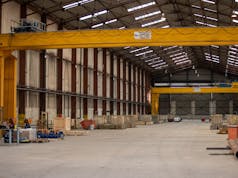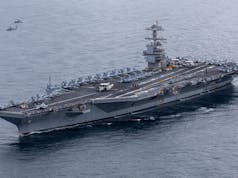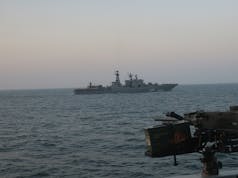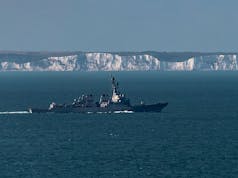UK engineering firm STS Defence has secured a contract from Rohde & Schwarz Australia to provide integrated main communications masts for the Royal Australian Navy’s Hunter class frigates.
The deal covers two masts for each of the first three frigates in the programme, with the first ship-set due for delivery in 2028. All masts will be built in the UK before being shipped to Osborne Naval Shipyard in South Australia for installation.
STS Defence is the design authority for the masts, a role awarded after completing scoping, risk reduction and detailed design work that led to Lloyd’s certification. The design draws on the masts fitted to the Royal Navy’s Type 26 frigates, which share the same Global Combat Ship pedigree as the Hunter class.
According to STS Defence, the masts will carry a variety of antennas to provide line-of-sight communications across multiple frequency bands, along with masthead navigation lights. Composite isolation screens will separate different frequency bands to reduce interference.
Mainstay Marine Solutions in Pembroke Dock, Wales, will manufacture and assemble the mast structures before shipment to Australia.
“This is a flagship programme for STS Defence which showcases our technology, design and integration capabilities,” said Ben Stancliffe, the company’s managing director. “We are immensely proud to be providing this mission critical system to one of the most advanced warships in the world.”
Rohde & Schwarz Australia managing director Gareth Evans said STS Defence’s expertise was essential to the project’s success. “Their expertise in the design and manufacture of high-quality communications masts will be essential in ensuring the success of this program,” he said.
The Hunter class frigates are being built by BAE Systems Australia under a £35 billion programme to deliver nine anti-submarine warfare vessels based on the UK’s Type 26 design.














fairly sure the Hunter class was reduced from 9 to 6 ships
Not surprised if they cost £4 Billion each !
I think the figures quoted in £ should be in AUS$. Still works out at nearly £2 billion each though, which seems a bit steep for a frigate.
I think the Article figure is rather wrong and possibly confused.
A new rendering of the Hunter class was released recently – they’re not lookers to put it mildly
Ref to the new rendering?
A good win for STS Defence, though expect it might be only ~ 10% of the Rhode & Schwartz contract, R & S seem to have a very good reputation for their electronics.
Reminds me of Dave Lister’s head when he had the space mumps !
With the selection of 11 Mogami (so called Tier 2) frigates for the RAN, the fear is that the Hunter Class may enter a cost/capability/delivery ‘death spiral’.
The decision by the RAN to procure a Tier 2 frigate has already seen the Hunter program cut from 9 to 6 hulls putting upward pressure on unit costs.
There is little doubt the Hunter Class is technically superior as an ASW platform and with the Aegis/Ceafar combination as an air warfare platform.
However in some quarters (media) there are already new questions being asked about the value of the Hunter Class given the superficial similarities with the Mogami class. The risk is that this could translate into political pressures for the Hunter program.
Both Hunter and Mogami have:
32 cell strike length VLS (ESSM, SM2, SM6, Tomahawk)
8 NSM
5 inch deck gun
Torpedoes
AESA radar
Hull mounted sonar
Provision for towed array sonar
Hangar for Seahawk Romeo with dipping sonar
But the Mogami has:
Half the crew at 90 (downside for damage control but upside for recruitment and crewing)
Greater range (10,000 nm vs 7,000 nm)
SeaRAM CWIS (Phalanx deleted from Hunter?)
Lower cost per hull and more rapid production rates
A production rate (in Japanese shipyards) of less than 3 years (first ship 2.5 years from keel laying to commissioning anticipated 18 months for later hulls) compares to a projected 4+ years for Hunter and 8 years for first of class HMS Glasgow with and a planned 5 years for the rest of the T26 program.
The Mitsubishi yard has already slotted the RAN ships into its JMSDF production schedule.
The $10 billion cost for first 3 hulls (includes an assumed at least $1 billion for upgrades to the Henderson yard in Western Australia) so cost estimate for Japanese build Mogami is around $3 billion compared to the Hunter at an average of $6.4 billion per hull.
Given the competition from the Mogami it is understandable that BAE have developed an ‘up-gunned ‘ version with additional VLS cells (96 cells total) and double NSM loadout (it has the tonnage to allow for the growth but could run into top weight issues and further design delays).
So hopefully the appeal of a simplistic equation of a ship with the ‘same capabilities’ with half the crewing costs, for half the production cost delivered in half the time doesn’t gain traction.
the 8 years for HMS Glasgow isn’t really relevant. as the time scale was UK treasury driven
Fair enough, but the build time for the remaining T26 hulls is cited as 60 months (5 years). Hard to match the cost efficiency of Asian shipyards. I doubt the Australian production will ever reach the efficiency of British yards either let alone the Japanese (our track record isn’t great) so there is likely to be a temptation to produce even more of the Mogami frigates in Japan.
I’d be suspicious of what this export version of the Mogami is going to have. The Australian government said it was off the shelf. Yet we hear Australian defence ministers telling us it will have 128 missiles. Only possible by quad packing all 32 VLS with ESSM. They then say it will fire SM2/6. Which is only possible with the full Aegis suite. Which the current Mogami doesn’t have. Towed sonar array, which again the current Mogami doesn’t have. All of this with no increase in crew and no decrease in range. Not forgetting the radar OPY-2 radar, which doesn’t work with Aegis either.
Aegis isn’t necessary to fire SM2. The Netherlands De Zeven Provincien class frigates use an APAR and SMART-L radars with a Thales combat system.
German Saschen class has a similar system and the Anzac frigates with CEAFAR and SAAB 9LV combat system are now able to fire SM2 although typically they don’t carry them in their loadout since they only have 8 VLS cells and they need to max out their small magazine with quad packed ESSM
So it’s technically possible without Aegis – just much more difficult and a lot of system integration work and testing (read cost and time). What could possibly go wrong??
Indeed. However the combo I referenced SM2/6 requires Aegis. No one has done the integration work for SM6. So as of today, you would need Aegis. Which leaves you wondering if the Australian government know what they are buying. It would seem not. It’s both off the shelf and highly customised.
I very much doubt Mogami, Constellation or other frigates with similar size radars will ever be capable to make use of the SM-6 as an AAM . The Constellation cut down SPY-6(V)3 radar will not have the necessary range or sensitivity to target the SM-6 at its long range.
Agree that whatever radar the Mogami end up being fitted it is unlikely to have the power, range or sensitivity to cater for the performance envelope of a missile like the SM6.
However it might be able to launch an SM6 with targeting data handed off from another Aegis equipped RAN ship (Hobart or Hunter). Acting as an ‘arsenal’ ship it could extend and RAN task forces magazine depth for SM6.
The Australian Joint Integrated Fires (AJIF) capability is the Australian version of Cooperative Engagement Capability (CEC) fitted to the Hobarts with planned roll out to RAAF (Wedgetail) and army NASAMS). Mogamis could be ‘node’ in this system.
The notion of an ‘off the shelf’ purchase was always a convenient fiction. The Mogami will be customised for the RAN.
For info, apologies did not make source of quote “The Japanese new ship-to-air guided missile, A-SAM, based on the Japanese Army’s Type 03 Chu SAM plus booster started development in 2017 and test fired in Dec 2022 from Japan’s experimental ship JS Asuka and IOC 2024. The new A- SAMs intended to bring better range than ESSMs extending the air defense coverage of the ships, also as important as the development of the missile is the CMC incorporating the new data link, the Fire Control (FC) network, which aims to share radar information among ships. Planned as complimentary to the USN Data Distribution System (DDS) data link for its Cooperative Engagement Capability (CEC), the USN CEC aims to intercept approaching missiles and other missiles as far away as possible with the SM-2s and SM-6s whereas the Japanese FC network aims to efficiently intercept missiles that have slipped through the destroyers air defences with the A-SAM, reported the Type 03 SAM successfully shot down a Mach 2.5 Coyote at White Sand during trials.”
So Australians will have possible Japanese options other than all US which might not be always be the best option to be cast iron with Trump.
Possible but unlikely. Both Type 03 Chu and ESSM Block II have similar ranges at around 50km (SM2 is significantly longer ranged). However the Type 03 cannot be quad packed into a Mk 41 VLS like ESSM so that’s a significant reduction in magazine depth.
Unlikely the RAN will introduce another type to inventory given the logistical challenges that poses. Plus RTX (Raytheon) is setting up an Australian production facility to mitigate the long supply chain to the U.S.
But good to know the option is there as a fall back.
Pickelhaube. But less gothic than the proposed new French aircraft carrier.
Hmm. Where’s the balloon?
Those magnificent men in their ….